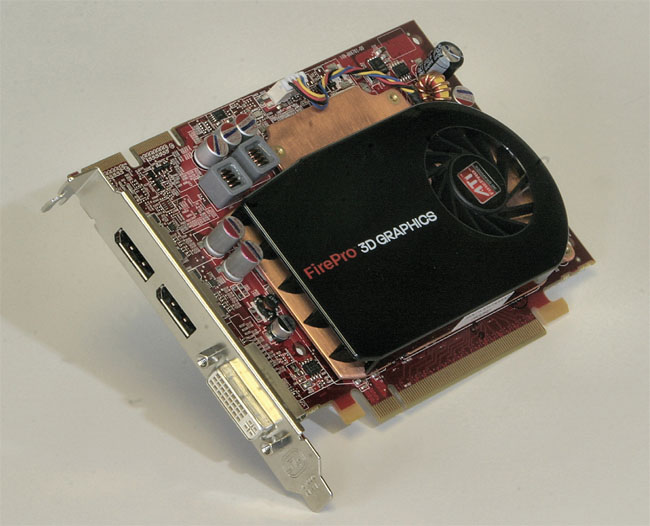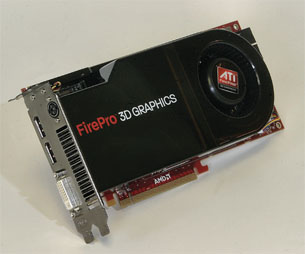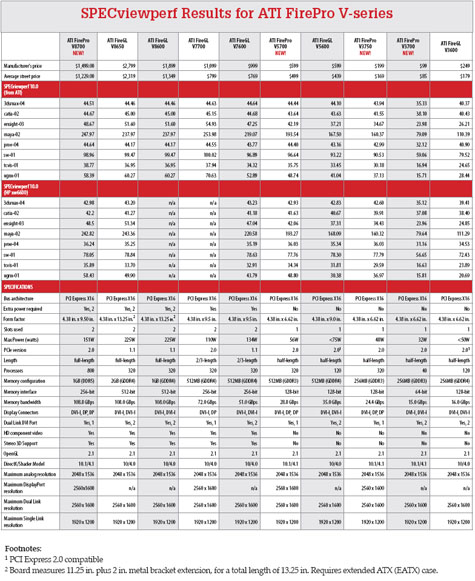ATI FirePro V-series Takes the Price/Performance Lead
AMD's new ATI workstation graphics accelerators yield improved performance at significantly lower prices.
December 4, 2001
By David Cohn
For years, ATI was the first to introduce new technology: the first PCI Express-based boards and the first workstation-class graphics accelerator with 1GB of onboard memory. But after being acquired in 2006 by Advanced Micro Devices (AMD), ATI seemed to lose its way for a while. NVIDIA, its primary competitor, beat ATI to the punch with its unified graphics architecture, replacing dedicated geometry engines and pixel shaders with a new design in which the power of the graphics processing unit (GPU) can be dynamically allocated to vertex or pixel shading, improving performance for all types of professional users.
 The entry level ATI FirePro V3750. Photos by David Cohn |
Last year, AMD began catching up, introducing its own new generation GPUs designed around a unified shader architecture, which the company calls Stream processors. The company also set a new industry milestone with its introduction of the first 2GB workstation graphics accelerator. More recently, the company became the first to introduce a 3D workstation-class graphics card with DisplayPort support.
Now AMD has completed the refresh of its entire workstation graphics product line with four new ATI FirePro V-series boards, including the top-of-the-line FirePro V8700, which we previously reviewed (see DE, April 2009). The new boards provide equal or better performance than last year’s FireGL boards at significantly lower prices.
All of the new FirePro V-series graphics accelerators also include AMD’s AutoDetect feature, which optimizes the graphics driver based on the user’s specific software applications even while running multiple programs simultaneously. With AutoDetect, users no longer need to manually adjust application-specific driver settings to achieve top performance.
All four boards in the new FirePro V-series are designed with a 10-bit display pipeline and support for high dynamic range (HDR) rendering, enabling the boards to produce more than one billion colors. All four boards are also PCI Express 2.0 compatible, support hardware acceleration of DirectX 10.1 and OpenGL 2.1 advanced features, and are compliant with Shader Model 4.1. All but the entry-level FirePro V3700 include a single DVI-I connector and a pair of the new DisplayPort (DP) connectors.
 The new high-end ATI FirePro V8700. |
The New ATI FirePro V Family
At the entry level, the new ATI FirePro V3700 ($99 MSRP/$85 average street price) provides 256MB of GDDR3 memory with a 64-bit memory controller. While those specs are similar to the previous generation FireGL V3600, the board’s GPU features just 40 unified shaders (compared to 120 in the V3600). The more modest GPU and a memory bandwidth of just 15GBps results in a slight decrease in performance but enables AMD to offer this entry-level 3D graphics board for less than $100, another industry first. The FirePro V3700 requires a single PCI Express X16 slot and consumes just 32 watts of power. The board provides two DVI-I ports, both supporting Dual Link.
Not wanting to short change entry-level users, AMD also released a more powerful entry-class board, the FirePro V3750 ($199 MSRP/$169 street). This board offers the same amount of memory as the V3700 but its new GPU provides 320 Stream processing units and increases the memory interface to 128-bit. With a memory bandwidth of 24.4GBps, the board still retains the small form factor as the V3700 and also keeps power consumption to just 48 watts. Yet the board outperforms last year’s entry-level graphics card while costing significantly less. The FirePro V3750 provides a single DVI-I port and two DP connectors, and comes with three useful adapters: DP to single link DVI-I, DVI-I to VGA, and DVI-I to component RGB.
The ATI FirePro V5700 is AMD’s new mid-range entry. With a suggested retail price of $599 ($499 street), it sets a new price/performance standard and is likely to become the most popular board in the new lineup. It’s no wonder. The diminutive V5700 requires just one PCIe X16 slot and consumes just 56 watts, yet provides 512MB of GDDR3 memory, a GPU with 320 unified shader processors, and a memory bandwidth of 28.8GBps. And, like the V3750, the V5700 provides one DVI-I port and a pair of DP connectors.
At the top of the new AMD lineup is the ATI FirePro V8700 ($1,499 MSRP/$1,229 street). This full-length board comes with 1GB of DDR5 memory and a 256-bit memory interface. Its GPU provides a whopping 800 unified shader processors (compared to 320 in last year’s FireGL V8600 and V8650). The FirePro V8700 has a memory bandwidth of 108.8GBps and provides both HD component video and stereo 3D support as well as a single DVI-I port and a pair of DP connectors. But at this level, all that power comes at the expense of higher energy consumption. The V8700 uses 151 watts, considerably less than its predecessor, but still requires two auxiliary connections to the system power supply. As with other ultra high-end boards, the V8700 has a large cooling fan that increases the overall thickness of the board to more than an inch, rendering the adjacent expansion slot unusable. |
Benchmarking the Boards
We tested the four new ATI FirePro boards using the same HP xw6600 workstation equipped with a pair of 3.0GHz Quad-Core Xeon E5450 processors, so all of our results are directly comparable. This is the same system we used to review the latest NVIDIA Quadro FX boards as well as the previous generation of ATI FireGL graphics boards, so readers can easily compare boards and see for themselves whether the performance improvements warrant upgrading from their current graphics boards.
All tests were performed using version 10 of the SPECviewperf benchmark at a resolution of 1280 x 1024. We also compared our results to those published on the AMD website. Our results closely parallel those published results.
While the new generation of ATI boards don’t provide the same speed improvement over the previous generation as we saw last year, the new ATI FirePro boards equal or surpass the performance of the older boards, while costing significantly less. All of the new ATI FirePro boards are fully certified with most CAD and DCC applications and use a unified video driver. Drivers are available for most 32- and 64-bit operating systems, including Vista, XP, and Linux.
With these new boards from AMD, ATI is once again competing head-to-head with NVIDIA. And when companies like that compete, users are the winners.
More Info
AMD
ATI Fire Pro V3700
> Price: $99 (suggested retail),$85 (average street)
ATI Fire Pro V3750
> Price: $199 (suggested retail),$169 (average street)
ATI Fire Pro V5700
> Price: $599 (suggested retail),$499 (average street)
ATI Fire Pro V8700
> Price: $1,499 (suggested retail), $1,229 (average street)
Contributing Editor David Cohn is a computer consultant and technical writer based in Bellingham, WA, and has been benchmarking PCs since 1984. He’s the former editor-in-chief of Engineering Automation Report and CADCAMNet, and the author of more than a dozen books. Please send comments about this article to [email protected]. You can also contact David at [email protected].
Subscribe to our FREE magazine, FREE email newsletters or both!
About the Author
David Cohn is a consultant and technical writer based in Bellingham, WA, and has been benchmarking PCs since 1984. He is a Contributing Editor to Digital Engineering, the former senior content manager at 4D Technologies, and the author of more than a dozen books. Email at [email protected] or visit his website at www.dscohn.com.
Follow DE





